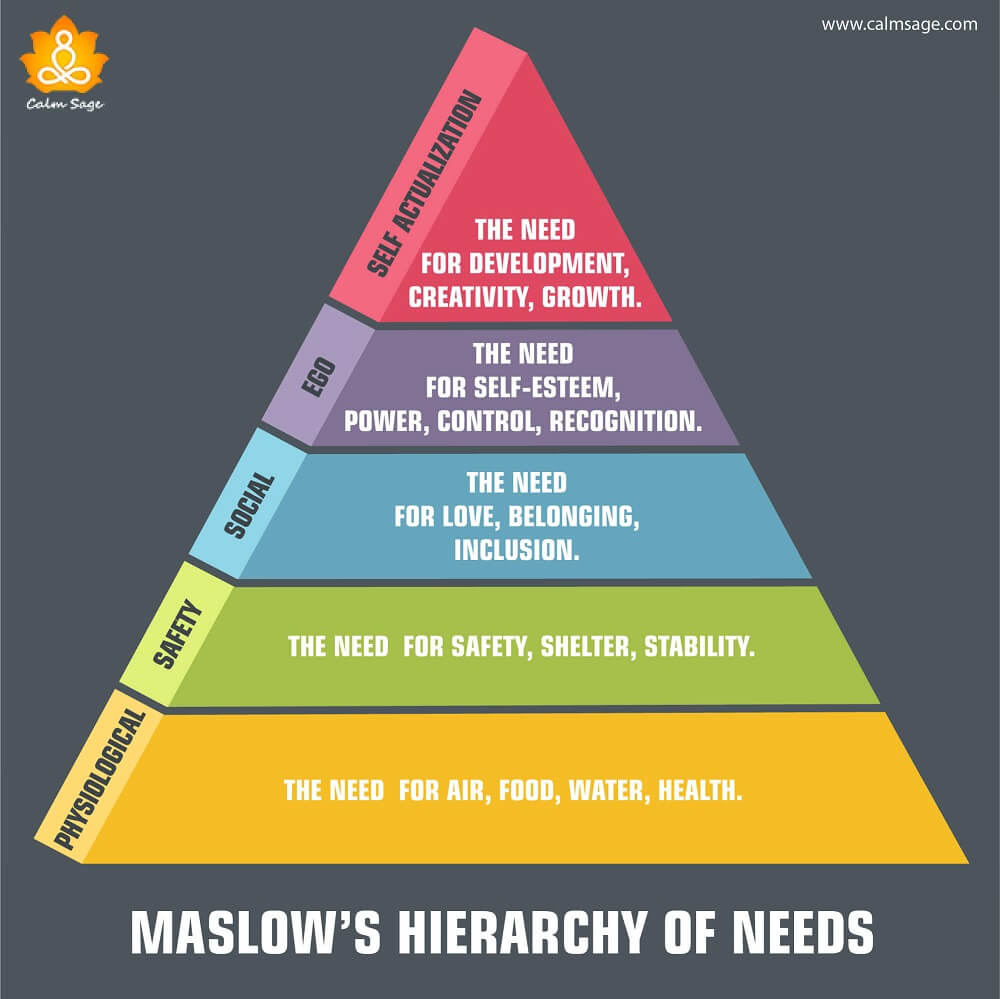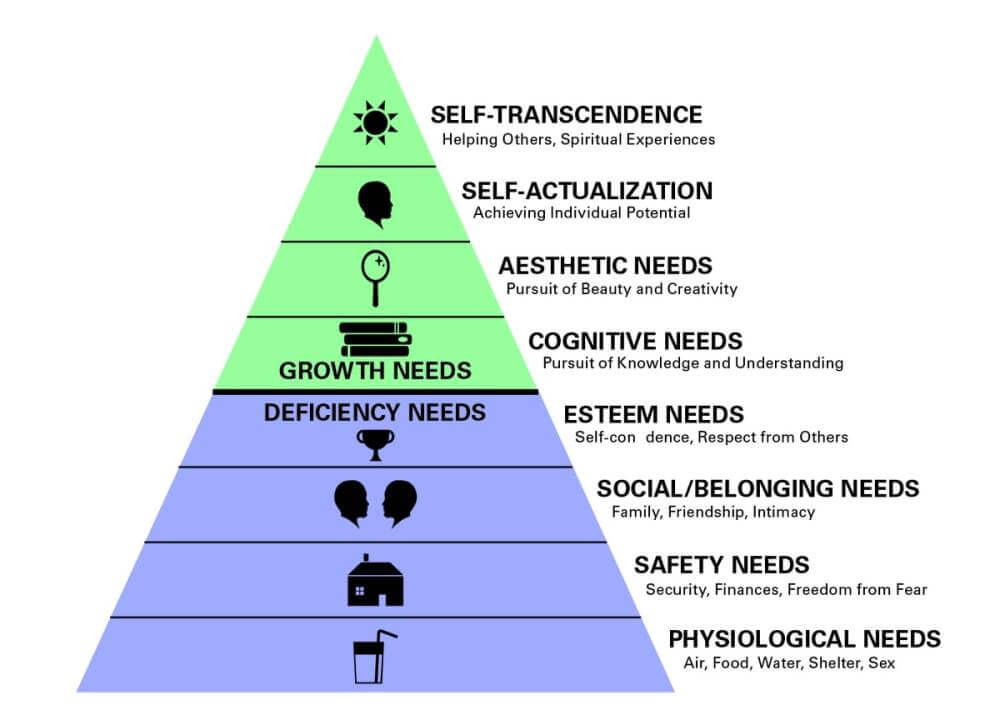Understanding Maslow’s Hierarchy of Needs: Know What You Really Want

If I ask you what are your needs? You will be able to pen down a long list of your needs. And well why not? Aren’t we all constantly striving and thriving to fulfill our needs and lead a happy life?
But are you planning to stick to the basic needs in life or you want to move to the growing needs and attain a sense of fulfillment in life? (Confused)
Well, yes, your needs have a classification, a theory, and a pyramid linked to it which supports our growth as an individual. This theory is popularly known as Maslow’s Hierarchy of needs. It is named after its creator Abraham Maslow.
Let us explore Maslow’s Hierarchy of needs in detail and check with ourselves how well are we doing in our lives and how far are we from reaching the zenith- Transcendence.
What is Maslow’s Hierarchy of Need:
Maslow’s hierarchy of needs pyramid is considered to be the first building block that was laid in bringing the wave of positive psychology. The first representation of Maslow’s hierarchy of needs pyramid was seen in a paper titled “A Theory of Human Motivation” in 1943.

This Hierarchy of needs pyramid is arranged in sequence in order of their importance. Maslow suggested that till the lower needs are not met an individual can’t progress upward. Maslow also held the view that till the lower meets are not met an individual can’t progress upward on the pyramid.
What Is The Main Idea Behind Maslow’s Hierarchy of Needs Theory:
The theory behind Maslow’s hierarchy of needs pyramid is quite simple and straightforward. He suggested that the needs that are placed at the base of the pyramid which is also known as physiological needs and include things like food, water, and sleep must be met before people move further to fulfill higher needs in their life.
These needs are completely independent of each other if considered individually. However, the concept of the pyramid suggests that they are interrelated in the sense that when one need is fulfilled only then the next one can be worked upon.
It can be explained this way- until and unless your physiological needs are not satisfied, the need for belonging won’t arrive or if you are having safety and security needs satisfied but biological needs are unmet then you are likely to climb down the pyramid rather than climbing up on it.
5 Level of Maslow’s Hierarchy of Needs Pyramid Deconstructed
Here is a detailed description of Maslow’s Hierarchy of Needs:
1. Physiological Needs
Physiological needs are basic bodily needs that we need for survival. They are also referred to as biological needs. This includes air, food, water, shelter, sex, sleep, homeostasis among many. It includes needs like eating food when hungry, drinking water when thirsty.
If physiological needs are unmet then an individual might develop trust issues towards the environment along with feelings of anxiety neuroticism
2. Safety Needs
Once an individual’s physiological needs are met and satisfied the next need that arises is that of security and safety. This is the need to be free from any possible threat be it real or imaginable. This need is both physical and psychological in nature. Safety needs include emotional safety and protection along with physical and environmental safety. The underlying motive here is to be safe from harm.
If safety needs are not satisfied then feelings of doubt and shame are likely to swipe in.
3. Love and Belongingness Needs
The next need in the hierarchy is the need to belong, to affiliate, to love, and to be loved by others. This need includes both ties with friends and family members along with romantic relationships that we cherish as an individual. The basic motive behind this need is to not live a lonely life and have the company of others in dark times of life.
If an individual fails to develop close interpersonal relationships then negative social emotions like guilt, resentment might develop.
4. Esteem Needs
When the need for belongingness is satisfied, the individual strives for the need for self-esteem and develops a sense of self-worth. Maslow divided this need in his hierarchy of Needs theory into two different categories, first esteem for oneself and second the desire for reputation or respect from others.
Esteem for oneself involves feeling good about oneself and having self-confidence on the other hand the desire for reputation from others involves feeling valued by others and realizing that your achievements are recognized by people around you. The motive behind this need is to feel good about ourselves from within and from outside sources.
Feelings of inferiority and low agreeableness can be witnessed if an individual’s esteem needs are not satisfied.
5. Self-Actualization Needs
The need that tops Maslow’s hierarchy of needs pyramid is the need for self-actualization. This need means to attain the fullest development of one’s potential. People who reach or attain this need are found to be self-aware, socially responsible, creative, spontaneous, and open to new changes.
Along with this, they have a great sense of humor and the capacity to build deep interpersonal relationships. The underlying motive here is to have a sense of fulfillment in life.
It is interesting to note here that not many people achieve self-actualization. In fact, it is relatively rare. Examples of famous self-actualized individuals according to Maslow are Mother Teresa, Albert Einstein, and Abraham Lincoln.
Phases of Maslow’s Hierarchy of Needs Pyramid
Maslow revised his Hierarchy of Need model in 1970 and converted it into a 7 stage model, adding cognitive and aesthetic needs to it.
1. Cognitive Needs
Maslow believed that humans chase knowledge to increase their intelligence so he added cognitive needs in his hierarchy of needs pyramid that focuses on learning, discovering, and creating a better understanding of the world. The motive behind this need is to learn, explore, and welcome experiences in life.
2. Aesthetic Needs
This need focuses on beautiful imagery or aesthetically pleasing things around. This need not only allows an individual to absorb oneself in the beauty of nature but also to refresh themselves. The underlying motive of this need is exploring the beauty of nature.
In 1990 Maslow’s need of the Hierarchy pyramid went into another adoption and this time it came out as an eight-stage model with transcendence need to be placed at the top of the triangle.
3. Transcendence Needs
Later in his practice, Maslow divided the top of the triangle for the first time and placed self-transcendence need there. This need is often referred to as spiritual need. The fulfillment of this need leads to your feeling of integrity. The motive here is to help others achieve self-actualization.
After all these upgrades the Extended Maslow’s hierarchy of needs pyramid looks like this

Note: The bottom four needs of Maslow’s Hierarchy of Needs pyramid are referred to as deficiency needs or D-needs. On the contrary, the top four needs are labeled as Growth needs of G-needs.
New Maslow’s Hierarchy of Needs Examples
Each stage of Maslow’s hierarchy of needs is explained with an example below:
1. Biological and physiological needs – air, food, drink, shelter, warmth, sex, sleep, etc.
2. Safety needs – stability, freedom from fear, protection from elements, security, order, law,
3. Love and belongingness need – intimacy, trust, friendship, and acceptance, receiving and giving affection and love, being part of a group (family, friends, work).
4. Esteem needs – (i) esteem for oneself (dignity, achievement, mastery, independence) and (ii) the desire for reputation or respect from others (status, prestige).
5. Cognitive needs – the need for meaning and predictability, knowledge and understanding, curiosity, exploration.
6. Aesthetic needs – appreciation and search for beauty, balance, form, etc.
7. Self-actualization needs – realizing personal potential, self-fulfillment, seeking personal growth, and peak experiences. A desire “to become everything one is capable of becoming”.
8. Transcendence needs – mystical experiences and certain experiences with nature, aesthetic experiences, sexual experiences, service to others, the pursuit of science, religious faith, etc.
Well, now time for you to check where you are standing in Maslow’s Hierarchy of Need pyramid. Time to move further and grow!
You May Like These Also:





















Great post! Maslow is such an important tool in the roots of positive psychology!!!
Great post, I've been struggling with an assignment and have been stuck on the "What" question, this morning i had a light globe moment and thought. go back to basics and take a look at Maslow's. after searching and reading for a while. this is it, exactly the context that I have been looking for.
Great uplifting text. I was down this morning and reviewed these needs. It perked me up.